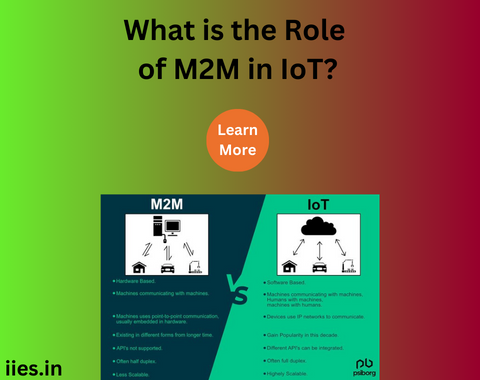
The Internet of Things (IoT) has revolutionized the way we interact with technology, connecting devices and systems to enhance efficiency and improve our daily lives. At the heart of this interconnected ecosystem lies Machine-to-Machine (M2M) communication, a critical component that facilitates seamless data exchange between devices without human intervention. In this article, we delve into the intricacies of M2M in IoT, exploring its significance, applications, challenges, and the transformative impact it has on various industries.
M2M communication refers to the exchange of data between machines or devices within the IoT framework, enabling them to communicate and collaborate without human intervention. This process involves sensors, actuators, and other devices equipped with embedded technology that allows them to collect and transmit data autonomously.
1. Efficiency and Automation:
M2M communication plays a pivotal role in enhancing efficiency through automation. Devices can share information in real-time, enabling quicker decision-making and reducing the need for human intervention. This is particularly valuable in industrial settings where processes can be optimized for maximum productivity.
2. Remote Monitoring and Control:
The ability to remotely monitor and control devices is a key advantage of M2M in IoT. From smart home applications to industrial machinery, M2M enables real-time monitoring, preventive maintenance, and the ability to intervene or adjust settings remotely.
3. Data-driven Insights:
M2M communication generates a wealth of data that can be analyzed to extract valuable insights. Businesses can leverage this data to make informed decisions, predict maintenance needs, and identify patterns that drive operational improvements.
Applications of M2M in IoT:
1. Smart Cities:
M2M communication is a cornerstone of smart city initiatives. From intelligent traffic management to waste management systems, interconnected devices enable cities to operate more efficiently, reduce energy consumption, and enhance the overall quality of urban living.
2. Healthcare:
In healthcare, M2M facilitates the creation of smart medical devices and remote patient monitoring systems. Wearable devices, sensors, and healthcare equipment can seamlessly communicate, providing real-time health data that can be used for diagnosis and personalized treatment plans.
3. Supply Chain and Logistics:
The logistics industry benefits from M2M communication through real-time tracking of shipments, monitoring environmental conditions during transportation, and optimizing routes for efficiency. This not only improves the reliability of deliveries but also reduces costs.
4. Manufacturing and Industry 4.0:
M2M communication is a driving force behind the fourth industrial revolution, commonly known as Industry 4.0. Connected machines and devices in manufacturing environments enable predictive maintenance, smart factories, and increased production efficiency.
Challenges and Considerations:
While M2M communication brings numerous benefits, it also presents challenges that need to be addressed:
1. Security Concerns:
With the increasing number of connected devices, the risk of cybersecurity threats grows. Ensuring the security of M2M communication is paramount to protect sensitive data and maintain the integrity of connected systems.
2. Interoperability:
The diverse array of devices in the IoT ecosystem may use different communication protocols and standards. Achieving seamless interoperability between devices is a challenge that requires industry-wide collaboration.
3. Scalability:
As IoT deployments expand, the scalability of M2M communication becomes crucial. Systems must be able to handle the increasing volume of data generated by a growing number of connected devices.
4. Data Privacy:
The extensive collection of data in M2M communication raises concerns about privacy. Striking a balance between collecting valuable data and respecting user privacy is a challenge that requires careful consideration.
Future Trends and Innovations:
Looking ahead, several trends and innovations are likely to shape the future of M2M communication in IoT:
1. 5G Connectivity:
The rollout of 5G networks enhances the speed and reliability of M2M communication. This high-speed connectivity is crucial for applications that require real-time data exchange, such as autonomous vehicles and augmented reality.
2. Edge Computing:
Edge computing, which involves processing data closer to the source rather than in a centralized cloud, is gaining prominence. This approach reduces latency and enhances the efficiency of M2M communication, especially in scenarios where real-time responses are critical.
3. Artificial Intelligence (AI) Integration:
AI technologies are increasingly being integrated into M2M communication to analyze vast datasets and extract actionable insights. This enables more intelligent decision-making and predictive capabilities.
Emerging Trends in M2M Communication in IoT:
Blockchain Integration:
Blockchain technology is gaining traction in M2M communication to address security and trust issues. By providing a decentralized and tamper-proof ledger, blockchain enhances the integrity of data exchanged between devices. This is particularly crucial in sectors like finance, where secure and transparent transactions are paramount.
Energy Harvesting:
As the IoT ecosystem expands, the demand for sustainable and energy-efficient solutions grows. Energy harvesting, the process of capturing and converting ambient energy into power, is an emerging trend in M2M communication. This allows devices to operate with minimal reliance on traditional power sources, making them more environmentally friendly.
Augmented Reality (AR) and Virtual Reality (VR):
The integration of AR and VR technologies with M2M communication opens up new possibilities for immersive and interactive experiences. In industries such as education, training, and healthcare, M2M-enabled AR and VR applications can enhance learning, simulate real-world scenarios, and improve overall user engagement.
Quantum Computing:
While still in its early stages, the advent of quantum computing holds promise for transforming M2M communication. Quantum computing’s ability to process vast amounts of data simultaneously can significantly accelerate the analysis of complex datasets generated by interconnected devices,
Machine-to-Machine (M2M) communication is the backbone of the Internet of Things (IoT), enabling seamless connectivity and data exchange between devices. Its impact spans across various industries, enhancing efficiency, automation, and data-driven decision-making. While M2M communication presents challenges, ongoing innovations in connectivity, edge computing, and artificial intelligence are paving the way for a future where interconnected devices play an even more integral role in our daily lives. As we continue to explore the possibilities of M2M in IoT, careful attention to security, interoperability, and privacy will be essential to unlock its full potential.
Indian Institute of Embedded Systems – IIES